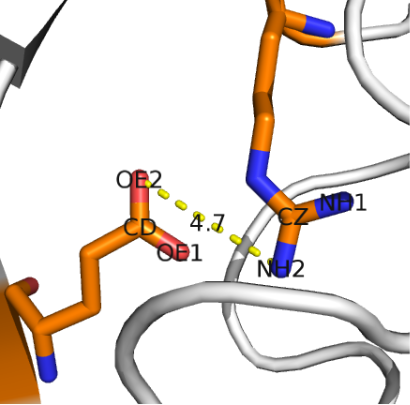 |
Structural Bioinformatics Library
Template C++ / Python API for developping structural bioinformatics applications.
|
 |
Structural Bioinformatics Library
Template C++ / Python API for developping structural bioinformatics applications.
|

Authors: F. Cazals and R. Tetley
This package provides elementary methods to detect selected pointwise interactions within molecules, such as:
This topic has a long history in structural biology [17] , [111], [71] . The difficulty in defining such interactions owes to (i) the dynamic nature of interactions, (ii) the charged status of atoms, (iii) the environment of residues, (iv) the multiplicity of H bonds (presence of bifurcated H bonds), etc.
Practically, we provide two methods to identify salt bridges. To describe them, recall that atoms of interest for acidic residues are:
Likewise, for basic residues:
Method 1, from [17] : based on inter atomic distances. The aforementioned atoms (one on the acidic residue, one on the basic residue) are identified. For two of them, if the minimum distance found is less than a threshold, the pair is termed a salt bridge.
Method 2, from [111] : based on distances between the center of masses of the charged groups. For both the basic and acidic residue, the center of mass of their charged groups are computed. If the distance between these is less than a user defined threshold (typically 4 ![]() ), the pair is termed a salt bridge.
), the pair is termed a salt bridge.
Disulfide bonds are defined as follows:
The following algorithms are used for proteins:
We provide to main classes to search for Pointwise interactions:
The template parameter has the following requirements:
The two classes provide a member function for finding salt bridges (or disulfide bonds).
SBL::CSB::T_Salt_bridges_finder< ParticleTraits >: By default, this class uses Method 1 described above. Alternatively, by using the option –use-center-of-mass, the user can specify that the algorithm should instead use Method 2 (based on the center of mass of charged atoms).
The output of both classes is a serialized list of the pairs of residues which form salt bridges or disulfide bonds.
The following example show how to compute the set of disulfide bonds from an input PDB file.
The following example show how to compute the set of salt bridges from an input PDB file.